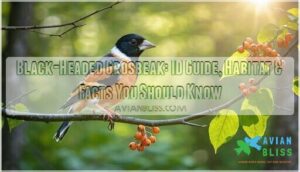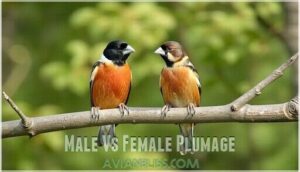This site is supported by our readers. We may earn a commission, at no cost to you, if you purchase through links.

You’ll find these 7-8 inch birds throughout western North America’s deciduous forests and woodland edges. Their song? Picture a robin that’s had a few too many—melodious but wonderfully wobbly.
They’re notable for their diet flexibility, consuming 60% insects during breeding season and uniquely digesting toxic monarch butterflies that would poison other birds.
Both sexes flash distinctive yellow wing linings during flight, making identification easier when they’re moving between perches in their preferred forest edge habitats.
Table Of Contents
- Key Takeaways
- Black-headed Grosbeak Identification Guide
- Habitat and Range of Black-headed Grosbeak
- Diet and Foraging Behavior
- Nesting Habits and Reproduction
- Conservation and Unique Adaptations
- Frequently Asked Questions (FAQs)
- How do you identify a Black-headed Grosbeak?
- What is the difference between a Towhee and a Black-headed Grosbeak?
- What is interesting about the Black-headed Grosbeak?
- Do Black-headed Grosbeaks eat monarch butterflies?
- How long do black-headed grosbeaks typically live?
- Do black-headed grosbeaks migrate? If so, where?
- Can black-headed grosbeaks imitate other bird songs?
- What are the main predators of black-headed grosbeaks?
- How long do black-headed grosbeaks live?
- When do juveniles get their adult plumage?
- Conclusion
Key Takeaways
- You’ll identify males by their jet-black heads and bright orange-cinnamon bodies, while females show brown streaking with buff underparts—both sexes flash distinctive yellow wing linings during flight.
- You can find these 7-8 inch songbirds in western North America’s deciduous forests and woodland edges, where they migrate up to 2,600 km annually between breeding grounds and Mexican wintering areas.
- You’ll notice their remarkable diet flexibility—they consume 60% insects during the breeding season and uniquely digest toxic monarch butterflies that would poison other birds through specialized liver enzymes.
- You’ll hear their melodious song that sounds like a "tipsy robin," and both male and female grosbeaks share unusual parental duties, including nest incubation and chick-feeding responsibilities.
Black-headed Grosbeak Identification Guide
Black-headed Grosbeaks stand out with their thick, seed-cracking bills and chunky 7-8 inch frames.
The sexes look completely different—males sport jet-black heads against warm orange-cinnamon bodies, while females wear mottled brown with soft buff undersides.
Both flash yellow wing linings when they take flight.
Males display striking black heads with bright orange-cinnamon bodies, while females show brown streaking with buff underparts, both species exhibiting yellow wing linings during flight.
Physical Appearance and Measurements
At first glance, the Black-headed Grosbeak’s sturdy build catches your eye. These stocky songbirds showcase distinctive physical characteristics that aid field identification:
- Size Shape: Length measures 7.1-7.5 inches with compact bodies larger than House Finches
- Bill Morphology: Thick, conical beaks designed for seed-cracking demonstrate specialized feeding adaptations
- Weight Variation: Adults range 1.2-1.7 ounces with 12.6-inch wingspans displaying sexual dimorphism
Male Vs Female Plumage
While both sexes share the blackheaded grosbeak characteristics of thick bills and compact builds, sexual dimorphism creates striking plumage differences. Male grosbeaks sport jet-black heads contrasting with bright rufous-orange underparts and bold white wing patches. Female grosbeaks display subtler brown and buff streaking with warm cinnamon highlights.
These color differences serve practical purposes—bright male plumage helps establish territory and attract mates, while the female’s earth-toned feathers keep her hidden when she’s sitting on eggs.
Song and Vocalizations
You’ll recognize the Blackheaded Grosbeak’s sweet song that sounds like a tipsy robin. Both sexes are loud songbirds with complex song patterns.
Females sing simplified versions of male songs, and their call features crisp pik or sharp eek sounds. This grosbeak song demonstrates impressive vocal mimicry and call variations throughout their range.
You can explore recordings of their vocalizations in the Macaulay Library collection.
Comparison With Similar Species
You’ll encounter several Similar Songbirds that share the Black-headed Grosbeak’s sturdy build and woodland habits. Rose-breasted Grosbeaks show whiter bills and streaked breasts, while Evening Grosbeaks display bulkier frames with bright yellow plumage.
Size Comparison reveals Blue Grosbeaks measure smaller at 14-15 cm versus the Black-headed’s 18-19 cm. Habitat Overlap occurs where ranges meet, creating Behavioral Differences in foraging patterns between these Grosbeak characteristics. The Blue Grosbeak, in contrast, displays rich blue plumage.
Habitat and Range of Black-headed Grosbeak
You’ll find Black-headed Grosbeaks across western North America, from southwestern Canada down to central Mexico’s mountains. They prefer deciduous forests, woodlands, and edge habitats.
These birds migrate from their northern breeding grounds to winter in central Mexico.
Preferred Habitats and Vegetation
You’ll find Black-headed Grosbeaks thriving in forest edge habitats where deciduous trees meet open woodlands.
These birds show a strong shrub preference, choosing areas with moderate vegetation density that offers both foraging opportunities and nesting cover. Their habitat selection reflects a perfect balance—dense enough for protection, open enough for movement through the canopy layers.
Geographic Distribution and Migration Patterns
Black-headed Grosbeaks cover incredible ground, from southwestern Canada all the way down to Mexico’s central highlands. These birds pull off some serious marathon flights—we’re talking up to 2,600 kilometers each year.
What’s really interesting is how early they get started, taking off in mid-July when you’d expect them to still be settling in. Their travel routes get shaped by climate changes and how well different habitats connect, creating four main migration patterns:
- Spring corridors through California’s low-elevation valleys
- Molt-migration stopovers in northwest Mexico’s monsoon regions
- Wintering grounds from Baja California to Tehuantepec
- Range expansion eastward into Great Plains hybrid zones
Seasonal Occurrence by Location
You’ll spot BlackHeaded Grosbeaks at feeders from April through July across their breeding range. These migratory birds arrive late spring and depart early fall.
Migration timing varies by location—southern areas see them first. Northern populations show higher regional abundance during peak breeding season.
Post-breeding dispersal begins mid-July as birds prepare for wintering grounds in Mexico.
Diet and Foraging Behavior
You’ll observe Black-headed Grosbeaks using their powerful bills to crack tough seed shells and strip bark to find insects underneath.
These adaptable foragers consume approximately 60% insects during breeding season, including beetles and caterpillars, while also eating seeds, berries, and even toxic monarch butterflies that other birds avoid.
Insect Consumption and Foraging Techniques
You’ll watch Black-Headed Grosbeaks hunt with impressive skill across their foraging habitat preference. These birds show striking insect diet diversity throughout the breeding season, when insects make up 60% of their intake.
As seasons change, these birds switch up their hunting tactics in three main ways:
- Gleaning – searching through foliage for beetles and caterpillars
- Hovering – snatching insects mid-flight from leaves
- Ground foraging – picking up grasshoppers and other prey
Grosbeak digestive enzymes help process even toxic monarch butterflies efficiently.
Seed and Berry Feeding Preferences
Black-headed grosbeaks shift their seed preferences throughout seasons, favoring black oil sunflower seeds at feeders. Their strong, conical beaks handle tough seed shells effortlessly.
You’ll find them cracking open various berry varieties, including elderberries and blackberries.
During autumn, these birds increase seed consumption considerably, building fat reserves for migration while maintaining nutritional balance.
Unique Dietary Adaptations (Monarch Butterflies)
Unlike most birds that steer clear of monarch butterflies, Black-headed Grosbeaks have figured out how to eat these toxic insects safely. They’ve developed some pretty impressive adaptations:
Unlike most birds that avoid toxic monarch butterflies, Black-headed Grosbeaks evolved specialized adaptations to safely digest these poisonous insects
- Toxin neutralization through evolved genetic mutations
- 8-day feeding cycles that give their bodies time to clear the toxins
- They actually benefit from the huge monarch populations during migration season
- Special digestive adaptations that help them handle cardiac glycosides
It’s a perfect example of how evolution finds creative solutions to seemingly impossible problems.
Nesting Habits and Reproduction
You’ll find black-headed grosbeaks construct their cup-shaped nests in dense foliage using twigs, grasses, and pine needles.
Both parents share incubation duties for their 3-4 pale greenish-blue eggs spotted with reddish-brown markings.
Nest Construction and Location
Female black-headed grosbeaks commonly construct their cup-shaped nests using twigs, grasses, and pine needles in dense foliage. You’ll find these nest materials woven together about 4-12 feet high in deciduous trees or shrubs.
The nest height and camouflage help protect against predators, though nesting success varies by location within their habitat range.
Egg Characteristics and Incubation
Generally, you’ll find three to four pale greenish-blue eggs in each clutch, decorated with reddish-brown spots that create nature’s own artwork.
The incubation period spans 12-14 days, with both parents sharing daytime duties. However, only the female manages nighttime incubation.
This shared parental care boosts hatching success rates markedly compared to species where only one parent incubates.
Parental Roles and Chick Development
You’ll witness nature’s teamwork at its finest with black-headed grosbeaks. Both parents share Parental Care duties:
- Both sexes feed nestlings insects and regurgitated food
- Males continue caring for fledglings while females start new nests
- Chick Growth spans 9-12 days before leaving the nest
- Parents defend territory through song and aggressive displays
- Fledgling Success improves with equal parental investment
This Blackheaded Grosbeak characteristics ensures strong Brood Survival.
Conservation and Unique Adaptations
You’ll discover that Black-headed Grosbeaks face habitat loss from climate change and urban development, yet their populations remain stable with about 15 million breeding pairs.
These exceptional birds can safely digest toxic monarch butterflies through specialized liver enzymes, and males develop their striking black head plumage through controlled molting patterns that occur after their first breeding season.
Population Trends and Conservation Status
You’ll find reassuring news about Black-headed Grosbeak populations. These migratory birds maintain stable numbers with 12-15 million individuals globally. Conservation efforts focus on migratory bird protection, though habitat loss creates regional challenges.
The species shows exceptional resilience—Canadian populations have nearly doubled since 1970. While some areas face population decline from habitat loss, overall species survival remains secure with low conservation concern status.
Climate Change and Habitat Threats
Black-headed Grosbeaks are getting squeezed from all sides. Climate change and habitat loss have wiped out over 30% of their California breeding grounds in just 50 years. As temperatures rise, these birds are being pushed further north and higher up mountain slopes.
- Habitat Destruction – Agricultural conversion reducing nesting sites by 60%
- Ecosystem Disruption – Drought increasing by 45% since 2000
- Range Contraction – 58% summer range loss projected by 2080
- Biodiversity Loss – Fragmented forests supporting half the density
- Migratory Bird Protection – Delayed monsoons disrupting molt timing
The situation is urgent. Without quick action on grosbeak conservation, we could lose these beautiful birds entirely.
Interesting Facts and Adaptations (e.g., Detoxification, Plumage Development)
You’ll discover a fascinating Evolutionary Trait in the Blackheaded Grosbeak: evolved mutations in its sodium pump that are identical to monarch butterflies, enabling Toxicity Resistance to cardiac glycosides.
These Detoxification Methods include feeding on monarchs in roughly 8-day cycles to eliminate toxins. This striking adaptation proves these Adaptive Behaviors represent convergent evolution between predator and prey.
Frequently Asked Questions (FAQs)
How do you identify a Black-headed Grosbeak?
Look for males with striking black heads and bright orange-rufous chests. Females show brown streaking with buff coloring.
Both sexes display thick, conical bills and distinctive yellow wing linings during flight.
What is the difference between a Towhee and a Black-headed Grosbeak?
Imagine two birds as puzzle pieces from different sets. Towhees are large sparrows with triangular, seed-cracking bills and long rounded tails.
Grosbeaks have much thicker necks, conical bills, and shorter tails with distinctive rufous-orange plumage patterns.
What is interesting about the Black-headed Grosbeak?
You’ll find these songbirds fascinating because males share incubation duties with females, they fearlessly eat toxic monarch butterflies, and their strong beaks crack tough seeds effortlessly.
Do Black-headed Grosbeaks eat monarch butterflies?
Surprisingly, these songbirds consume toxic monarch butterflies despite their bitter taste and poisonous compounds. You’ll find them uniquely tolerant to toxins that would sicken other birds, making monarchs a regular part of their diverse diet alongside beetles and seeds.
How long do black-headed grosbeaks typically live?
You’ll generally see these songbirds living 5-6 years in wild conditions, though they can reach up to 25 years when properly cared for in captivity.
Do black-headed grosbeaks migrate? If so, where?
Yes, they’re impressive migrants! Northern populations travel roughly 2,000 miles to winter in central Mexico, while southern birds stay put year-round. You’ll spot them heading south in late summer.
Can black-headed grosbeaks imitate other bird songs?
Black-headed grosbeaks don’t usually imitate other bird songs. Instead, they produce their own distinctive, robin-like warbling with sweet whistles and an operatic quality.
However, they lack the vocal mimicry abilities found in species like mockingbirds or starlings.
What are the main predators of black-headed grosbeaks?
These songbirds face serious threats from outdoor cats, Scrub Jays, Steller’s Jays, and birds of prey.
Window collisions and vehicle strikes also threaten their survival markedly.
How long do black-headed grosbeaks live?
You’ll find these songbirds live about 5-6 years in the wild, though they can reach 25 years in captivity. Their natural lifespan depends heavily on habitat quality and predator pressure.
When do juveniles get their adult plumage?
Picture a young bird shedding its faded summer coat for vibrant adult colors. You’ll see juveniles acquire their full adult plumage at two years old through their first complete molt.
Conclusion
Like a vibrant jewel among the forest canopy, the black-headed grosbeak stands as one of western North America’s most distinctive songbirds. Whether you’re spotting their yellow wing linings in flight or hearing their melodious songs, black-headed grosbeaks offer endless fascination for birders.
You’ll find these outstanding birds adapting to changing environments while maintaining their unique ability to process toxic prey that would harm other species. Their flexible diet, striking plumage differences between sexes, and specialized adaptations make them truly outstanding members of the cardinal family worth observing and protecting.
- https://www.allaboutbirds.org/guide/Black-headed_Grosbeak/lifehistory
- https://naturecounts.ca/nc/socb-epoc/species.jsp?sp=bkhgro
- https://www.birdpop.org/docs/pubs/Saracco_et_al_2022_Demographic_Responses_to_Climate.pdf
- https://www.nps.gov/articles/000/sfanblog_four-birds-from-golden-gate-and-yosemite-star-in-new-study.htm
- https://animaldiversity.org/accounts/Pheucticus_melanocephalus/













